Indonesia Cultural Discovery
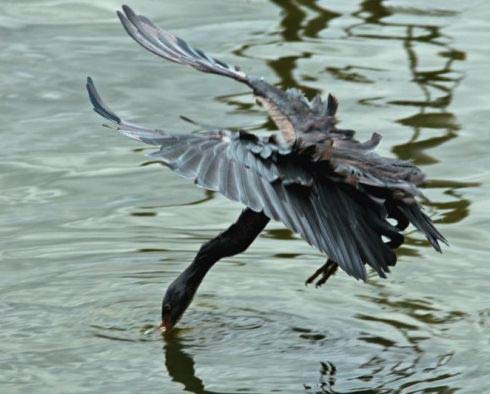
Choose where you sleep
The nation of Indonesia stretches along an equatorial archipelago numbering nearly 18,000 islands in total. Encompassing several ecosystem types as well as straddling the boundaries between the Oriental and Australasian faunal regions, Indonesia is one of the most biodiverse nations on Earth.
The high level of biodiversity is amply reflected in Indonesia's avifauna with some 17% of the world's total bird species represented. In quantifiable terms this translates to a national bird list of 1,539 species of which 381 are endemics!Our tour is designed to take us through some of the most accessible, though nonetheless exciting, sites for international arrival birders. Java, the political, cultural, economic and population centre of the country has a bird list of 473 species, 28 of which are endemic, while Bali's list stands at 317, the only endemic, the unique Bali Starling or Rothchild quote s Mynah (Leucospar rothschildi).
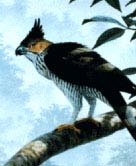 Throughout the tour birders will be met by a tremendous scenery of volcanoes, asian rural charm, lowland rainforest, wetlands and mangroves and stunning shorelines. Added into the mix is also the unmisseable culture of the Indonesian people to appreciate, whether it be shadow puppet plays in Java (wayang golek) or everyday ceremonial processions in Bali, this is more than just a tour for the birds.
Throughout the tour birders will be met by a tremendous scenery of volcanoes, asian rural charm, lowland rainforest, wetlands and mangroves and stunning shorelines. Added into the mix is also the unmisseable culture of the Indonesian people to appreciate, whether it be shadow puppet plays in Java (wayang golek) or everyday ceremonial processions in Bali, this is more than just a tour for the birds.
Birding Locations and possible sightings
Pulau Dua (West Java)A coastal reserve in north-west Java with a large Cormorant and Heron colony. Javan White-eye have been seen in the area.
Birds:-
Cotton Pygmy-goose: only a few recent records. Grey Teal: a few in small ponds. Savannah Nightjar: common in the open areas. Island Collared-Dove: common. Oriental Darter: fairly common. Little Black Cormorant: common. Little Egret: the subspecies nigripes with black feet. Pacific Reef-Egret. Grey Heron. Purple Heron. Great Egret. Intermediate Egret. Cattle Egret. Striated Heron. Black-crowned Night Heron. Rufous Night Heron: formerly bred here. Glossy Ibis: common. Black-headed Ibis: common. Milky Stork: a few. Lesser Adjutant: a few. Black-winged Starling: a few near the tower by the guard post. Javan White-eye: in coastal scrub. Streaked Weaver: large group near Sawar Luhur. Red Avadavat: a few near Sawar Luhur.
Other animals:-
Fishing Cat: relatively easily seen.
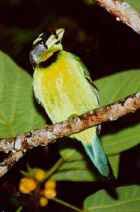 Carita (West Java)
Carita (West Java)
A locality on the west coast with some lowland forest left where the threatened White-breasted Babbler can still survive. There is a road into the forest which continues as a path to the waterfall. There are also several side trails.
Birds:-
Black-banded Barbet: several. Javan Kingfisher: a few in the open areas at the bottom of the track. Red-billed Malkoha: a few. Javan Owlet: an endemic. Black-naped Fruit-Dove: several. Javan Hawk-Eagle: rare. Banded Pitta: fairly common. Banded Broadbill: a few. Chestnut-capped Thrush: a few. Sunda Forktail: above the waterfall. Bar-winged Prinia: common. Horsfield's Babbler: several pairs. Large Wren Babbler: a few. White-breasted Babbler: fairly common in the primary forest near the waterfall. Grey-cheeked Tit Babbler: fairly common. Scarlet Sunbird: a few.
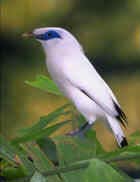 Other animals:-
Other animals:-
Wild Pig (Sus scrofa), Silvered Leaf Monkey (Presbytis cristata), Colugo (Cynocephalus variegatus).
Bogor Botanical Gardens (West Java)These gardens provide an interesting place for a birding visit. They are located in the centre of Bogor. We have deliberately avoided visiting the gardens during the weekends as hundreds of local city dwellers come over from Jakarta for a picnic. The trees behind the National Herbarium are a roost for a few nice species.
Birds:-
Fulvous-breasted Woodpecker: fairly common. Laced Woodpecker: one. Blue-eared Kingfisher: a few. Collared Kingfisher: common. Spotted Dove: common. Pink-necked Green Pigeon: fairly regular. Grey-cheeked Green Pigeon: a few. Black-naped Fruit Dove: a few. Black-crowned Night Heron: there is a colony on an island in the main pond. Black-naped Oriole: common, but difficult to find. Pied Fantail: a few. Common Iora: common. Chestnut-capped Thrush: a few. Orange-headed Thrush: a few. Oriental Magpie Robin: common. Pale-bellied Myna: a few. Sooty-headed Bulbul: common. Bar-winged Prinia: common. Oriental White-eye: common. Scarlet-headed Flowerpecker: a few. Plain-throated Sunbird: a few. Olive-backed Sunbird: common. Javan Munia: in the trees behind the National Herbarium. Scaly-breasted Munia: in the trees behind the National Herbarium. White-headed Munia: one small group. Java Sparrow: in the trees behind the National Herbarium. Best in the late afternoon.
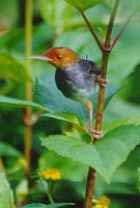 Other animals:-
Other animals:-
There is a large roost of Flying Foxes (Pteropus vampyrus) in the middle of the gardens. We also found a 1,5 meter long Water Monitor (Varanus salvator).
Gunung Gede Pangrango National Park (West Java)This park is centred around the twin volcanic peaks of Gunung Gede (2,958 m) and Gunung Pangrango (3,019 m). The habitat is mainly montane forest. Almost all the montane Javan endemics can be found here! At the base of the park are the Cibodas Botanical Gardens, also very good for birding. Near the guesthouse in the botanical gardens is a zig-zag path which is very good at first light. The main trail can be crowded during weekends and holidays.
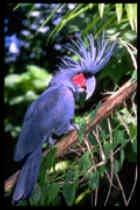 Birds:-
Birds:-
Chestnut-bellied Partridge: can be regularly heard. Crimson-winged Woodpecker: we have seen just one. Brown-throated Barbet: fairly common. Blue-eared Barbet: fairly common. Blue-tailed Trogon: above the Cibereum Waterfalls. Collared Kingfisher: common, Yellow-throated Hanging-Parrot: rare. Waterfall Swift: there was a colony at the Cibereum Waterfalls, but none seem to have been seen since 1989. Volcano Swiftlet: around the crater of Gunung Gede. Javan Scops Owl: this is a very difficult species from the lower part, no sound of adults have ever been heard, only contact calls of juvenile's! A few have been accidentally netted by bat trappers. Salvadori's Nightjar: regular around the Cibereum Waterfalls. Pink-necked Green Pigeon: a few. Sumatran Green Pigeon: rare. Dark-backed Imperial Pigeon: rare. Rufous Woodcock: occurs in the moss forest and can be seen flying over at absolute first light by the hut below the hot springs! Javan Hawk-Eagle: a good site seems to be the Cibereum Waterfalls. Short-tailed Magpie: rare. Sunda Minivet: common. Rufous-tailed Fantail: common. White-bellied Fantail: regularly seen in the area below the Cibereum Waterfalls. Ashy Drongo: common. Lesser Racket-tailed Drongo: a few. Sunda Whistling-Thrush: fairly regular. Orange-headed Thrush: a few. Sunda Thrush: at first light on the zig-zag path in the botanical gardens. Scaly Thrush: several. Island Thrush: around the crater rim. White-browed Shortwing: a few. Indigo Flycatcher: common Grey-headed Canary Flycatcher: a few. Sunda Robin: fairly common in lower altitudes and on the zig-zag path in the botanical gardens. Sunda Forktail: around the Cibereum Waterfalls and on the zig-zag path in the botanical gardens. White-crowned Forktail: on the zig-zag path in the botanical gardens. Javan Cochoa: difficult to see at lower altitudes. Blue Nuthatch: common in the botanical gardens. Pygmy Tit: common, particularly in the botanical gardens. Javan Grey-throated White-eye: common. Javan Tesia: common. Sunda Bush-Warbler: common. Sunda Warbler: common. Rufous-fronted Laughing Thrush: a few groups. Horsfield's Babbler: uncommon. Chestnut-backed Scimitar Babbler: we have seen just two. Eyebrowed Wren Babbler: fairly common. Pygmy Wren Babbler: common, and very tame. White-bibbed Babbler: fairly common. Crescent-chested Babbler: common. White-browed Shrike Babbler. Chestnut-fronted Shrike Babbler. Javan Fulvetta: common. Spotted Crocias: a few. Blood-breasted Flowerpecker: fairly common. White-flanked Sunbird: fairly common. Tawny-breasted Parrotfinch: fairly regular. Pin-tailed Parrotfinch: fairly regular. Javan Munia: botanic gardens. Mountain Serin: a few.
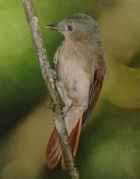 Other animals:-
Other animals:-
The park is home to many species of mammal. These include the Stink Badger (Mydaus javanensis), Flying Lemur (Galeopterus variegatus), Barking Deer (Muntiacus muntjak), Lesser Mouse-deer (Tragulus javanicus) and two species of wild pig (Sus scrofa and S. verrucosus). Four species of primate live here: Javan Gibbon (Hylobates moloch), Javan Leaf Monkey, (Presbytis comata), Ebony Leaf Monkey (Trachyppithecus auratus) and Long-tailed Macaque (Macaca fascicularis). Other rare mammals include Leopard (Panthera pardus), Leopard Cat (Felis bengalensis) and Wild Dog (Cuon alpinus javanicus).
Bedugul Botanical Gardens (Central Bali)This is a nice site in the highlands with some montane forest on the hills. There is a good trail up through some nice forest around the crater rim above Lake Bratan. At weekends the place is crowded with tourists.
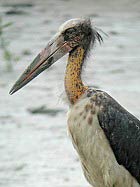 Birds:-
Birds:-
Orange-fronted Barbet: fairly common. Rainbow Lorikeet: has not been seen since the mid 80's and has probably been trapped out. Yellow-throated Hanging-Parrot: very rare due to trapping. Grey-cheeked Green Pigeon: common. Black-backed Fruit Dove: a few. Black Eagle: one. Indonesian Honeyeater: very common. Golden Whistler: a few around Lake Bratan. Sunda Whistling Thrush: a few. Orange-headed Thrush a few. Mountain White-eye: a few. Javan Grey-throated White-eye: common. Sunda Bush Warbler: a few. Russet Bush Warbler: recently found to be common on Bali. Sunda Warbler: a few. Horsfield's Babbler: a few near Lake Bratan. Chestnut-backed Scimitar Babbler: a few. Crescent-chested Babbler: common. Grey-cheeked Tit Babbler: fairly common. Blood-breasted Flowerpecker: common. Javan Munia: a few. Oriental White-eye: common.Bali Barat National Park (West Bali)The Bali Barat National Park is located on the north west tip of Bali. This reserve is the last site for the endangered Bali Myna. At Tegal Bunder it is possible to visit the Bali Myna project release centre. Pulau Menjangan is a small island that belongs to the reserve with some very beautiful coral reefs, it is also a good spot for Lemon-bellied White-eye. The park is pretty much left alone by the thousands of tourists that visit Bali each year.
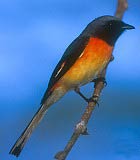 Birds
Birds
Green Junglefowl: a few at Tegal Bunder. Lineated Barbet: common. Dollarbird: fairly regular. Javan Kingfisher: rare. Collared Kingfisher: common. Sacred Kingfisher: common near the coast. Chestnut-headed Bee-eater: a few. Lesser Coucal: just seen one. Red-breasted Parakeet: at Tegal Bunder. Grey-rumped Tree Swift: a few. Savannah Nightjar: at Gilimanuk Bay. Spotted Dove: common. Island Collared Dove: a few. Orange-breasted Green Pigeon: a few. Grey-cheeked Green Pigeon: a few. Green Imperial Pigeon: a few. Common Sandpiper: common near the coast. Beach Thick-knee: a few on the beach. Brahminy Kite: fairly regular. Black-thighed Falconet: a few at Labuan Lalang. White-faced Heron: one at Labuan Lalang. Pacific Reef-Egret: on the beach. Striated Heron: on the beach. Lesser Adjutant: at Gilimanuk Bay. Banded Pitta: a few heard. Long-tailed Shrike: common. Racket-tailed Treepie: a few. White-breasted Woodswallow: a few at Tegal Bunder. Javan Cuckooshrike: one at Tegal Bunder. White-shouldered Triller: fairly common. Black Drongo: common. Common Iora: common. Oriental Magpie Robin: common. Black-winged Starling: a few. Bali Myna: extremely rare. Sooty-headed Bulbul: a few. Yellow-vented Bulbul: common. Lemon-bellied White-eye: common on Pulau Menjangan but has also been seen on the mainland. Striated Grassbird: a few. Australasian Lark: a few. Blood-breasted Flowerpecker: a few groups. Java Sparrow: rare.
Other animals:-
Black Giant Squirrel (Ratufa bicolor), Barking Deer (Muntiacus muntjak), Javan Rusa (Cervus timorensis),Lesser Mouse-deer (Tragulus javanicus), and Long-tailed Macaque (Macaca fascicularis).
Please note: This is only a sample itinerary of what is possible with Symbiosis. For exact details or more help planning the perfect escape, contact Symbiosis Expedition Planning.


